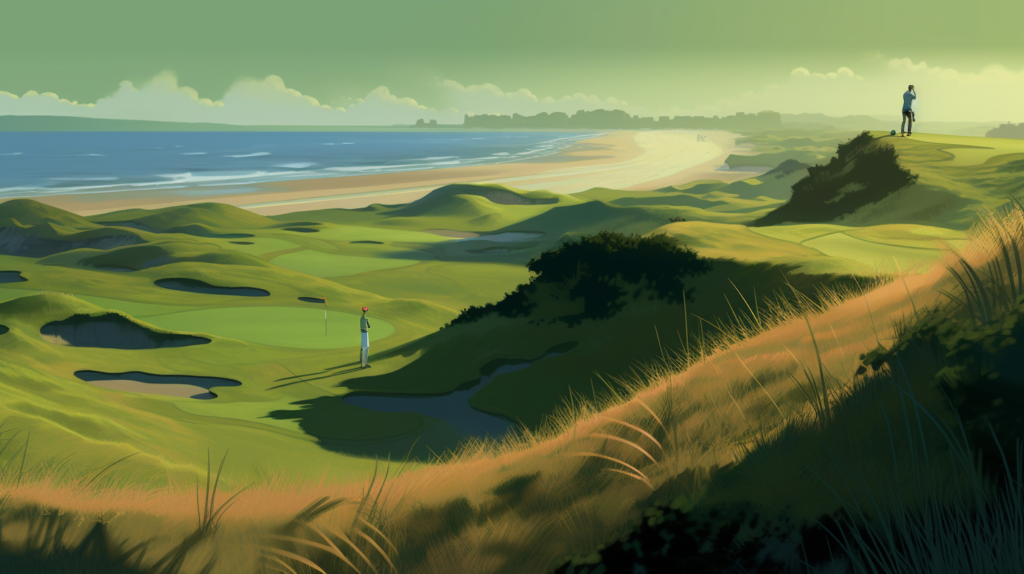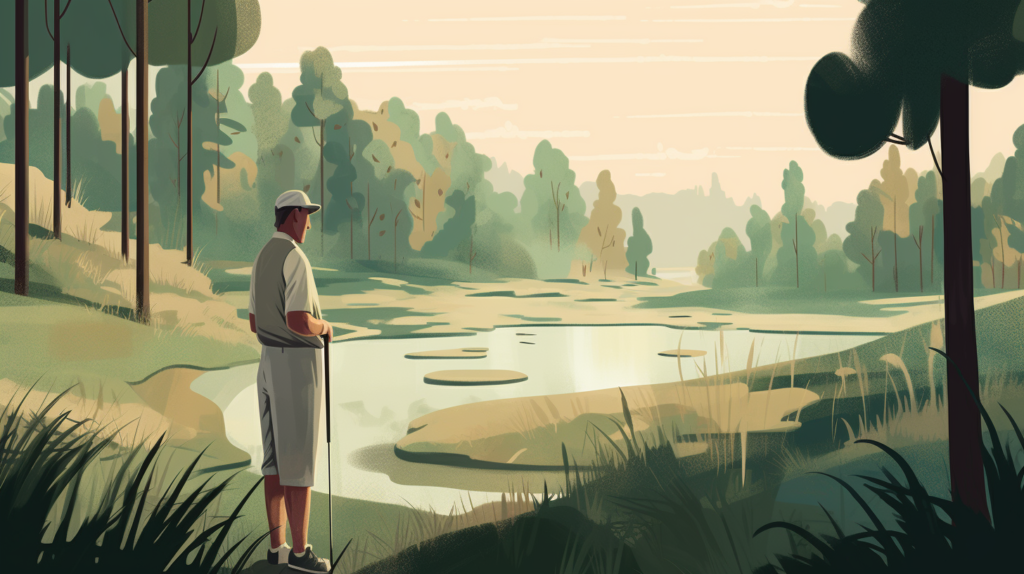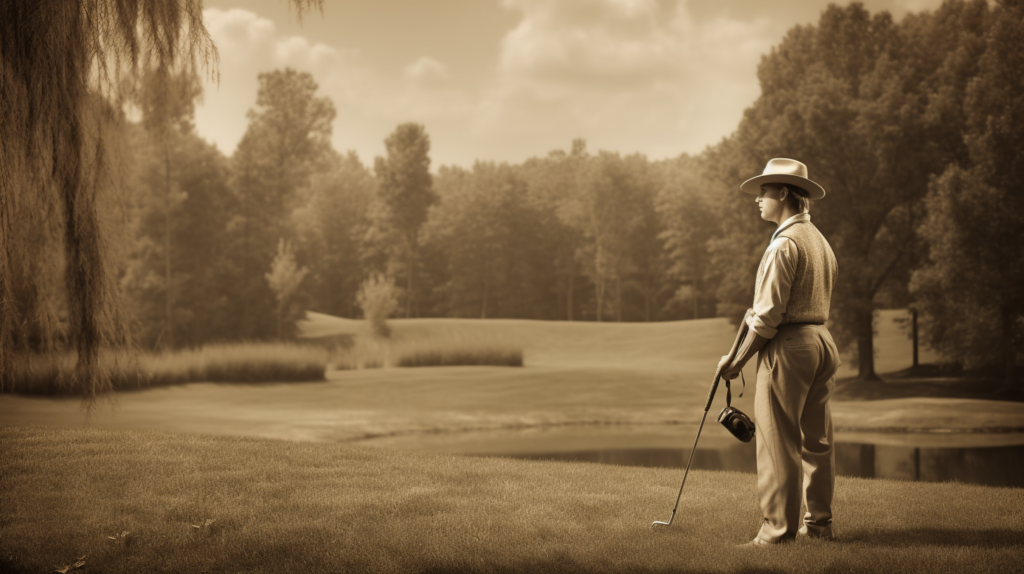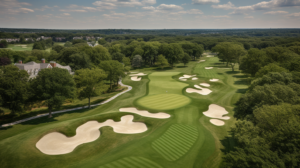Links golf only began because Scottish sheep liked to burrow into the sandy soil near beaches, creating uneven terrain perfect for hitting a golf ball.
Links golf courses retain the authentic spirit, charm and challenge inherent from golf’s origins along the coastal dunes and landscapes of the British Isles centuries ago.
Let’s dive into what makes links golf so unique and appealing even in the modern game.
What is a Links Golf Course

A links golf course is typically situated along a coastline, often on linksland, which is the undulating sandy terrain found near beaches. This sandy soil drains quickly, leading to the firm playing conditions links courses are famous for.
Many of the earliest links courses originated from golf’s homeland of Scotland, with historic classics like St Andrews Links dating back hundreds of years.
The natural features and landscapes where these courses were built essentially provided the template for what we now know as a traditional links course.
Unique Features of Links Golf Courses

Links golf courses have some unique properties that set them apart from traditional parkland or modern inland courses due to their coastal location and sandy terrain.
These distinctive features include the terrain, exposure to the elements, and the ability to remain firm and fast year-round.
Terrain
Links golf terrain tends to be sandy with little vegetation and exposure to coastal winds. There are natural rugged features like dunes, hills and valleys with the sea visible in the distance.
Fairways flow over and around these contours creating blind shots to elevated greens or dropping down into valleys before rising back up. Greens and fairways have tight lies on firm, springy turf that produces extra roll on shots as there is no lush grass to hold approach shots.
Natural Elements
The coastal location means links courses contend with strong winds, sea spray, rain and ever-changing weather. There is little shelter to hide from the elements among the dunes and hills.
Gusty winds significantly impact club selection and the flight of shots while rain softens fairways and greens temporarily before they drain and return to running fast.
The lack of trees exposes golf swings to the mercy of winds which is part of the charm and challenge of pure links golf.
Firm & Fast Conditions
The superb drainage characteristics of sandy links land provides for superior conditions year-round. Even in wet weather, water rapidly runs off the turf which then rebounds underfoot almost immediately.
This leads to fairways and greens remaining firm and fast allowing well-struck shots to gain extra zip and roll. Approaching firm greens with lower trajectory shots poses a stern test as the ball runs on and past the hole easily.
The two-tiered greens with bumps and hollows found on links courses push precision iron play to the limit.
Key Challenges in Playing a Links Course

Beyond the unique landscape features, links golf poses some singular performance challenges that test a player’s skill and adaptability beyond the typical course.
Wind
Coastal winds and frequent bad weather make club selection and shot execution extremely challenging. The arrow straight drives players are used to producing suddenly curve wildly off line if the wind gusts unexpectedly.
Even short putts break dramatically across slopes and tiers on greens by the wind’s influence. Local knowledge helps significantly, but links conditions always keep players guessing about wind effects.
Adjusting mid-round by playing low drives and bump and run approach shots often saves the day in blustery links conditions.
Accuracy
The nature of links courses puts a premium on accuracy to avoid disaster at the hands of penal bunkers, long grass and awkward lies.
While modern courses feature wide fairways, links courses require more precision off the tee as the old-fashioned fairways were much narrower with more undulations.
Wayward tee shots often finish in knife blade rough or deep pot bunkers – traditional hazards ready to swallow golf balls with their steep face walls. Recovery shots might mean hacking out backwards or taking a penalty stroke.
Once into the green surrounds, accurate irons shots that avoid greenside bunkers set up better birdie looks.
Creativity
The quest to negotiate links courses calls on players to use every shot in their arsenal at times. When the driving game goes awry, recovery shots with long irons, hybrids and fairway metals to reach greens in regulation become necessary.
Players also employ bump and run shots around the greens which involve running the ball over mounds and hollows allowing it to trickle towards the hole.
At times power is sacrificed for placement around the tricky green complexes to avoid falling victim to the many bunkers or hollows waiting nearby.
Famous Links Golf Courses & Tournaments

The coastal lands of the British isles are home to many of the most acclaimed golf courses in the world that have hosted historic championship moments.
Well-known courses
The British Open Championship rotates around 10 venerable links courses in Scotland and England which amply reflects the critical role linksland has played in golf’s development.
Legendary names include St Andrews, Carnoustie, Royal Troon, Turnberry, Royal Birkdale and Royal Lytham and St Annes among others. Northern Ireland’s Royal County Down and Royal Portrush have also entered the championship rota delivering magical performances.
For everyday play, lesser known but equally impressive Scottish layouts like North Berwick, Nairn and Dornoch capture the true spirit of links golf for visitors in dramatic fashion with holes playing directly along beaches and coves.
Signature tournaments held on links courses
The Open Championship, British Open or simply The Open held annually in the UK is world golf’s oldest tournament which began in 1860 at Prestwick Golf Club. Still known as the only “true” Open championship, it is exclusively played over classic seaside links on a rotating basis.
Similarly the Irish Open, Scottish Open and Women’s British Open take place over revered links like Royal County Down, Dundonald Links and Muirfield respectively.
America’s US Open and PGA Championship occasionally venture to linksland too with visits to Torrey Pines and Kiawah Island blending links features in California and South Carolina.
Links Golf Course Architecture & Design

From the earliest beginnings of golf, architects quickly identified that natural sandy linksland areas lent themselves perfectly to interesting and strategic golf hole design.
Architects
Many of golf’s early course architects emerged from links country and left an indelible impression on the evolution it.
Renowned Scottish greenkeeper Old Tom Morris established himself as a pioneering architect through outstanding renovations at St Andrews andASK before designing the likes of Royal County Down and Lahinch Golf Club in Ireland. C.B.
Macdonald and Seth Raynor carried his strategic design template to the USA through gems like National Golf Links and Shoreacres.
Donald Ross learnt the links game growing up in Dornoch before becoming prolific Stateside while the great Alister Mackenzie did likewise with his early works Royal St Georges and Alwoodley in England.
Design features
The natural topography and coastal landscape essentially formed a links course’s routing early on before advancements in design techniques emerged. Holes follow the natural movement and contours of sandy linksland heading out towards and back from the sea.
Early links courses from 150 years ago remain integral championship hosts today as the bones of their ingenious design stand the test of time. Greens and bunkers evolved over time into more elaborate shapes and patterns adding to strategic thinking and challenge.
Fairways also narrowed significantly over time and the Old Tom Morris formula of driving and approach play became entrenched as ideal links course architecture.
Other original features still present include blind tee shots over hills, exposed greens, penal rough areas, stone wall bulkheads and integrated dune landscapes.
The Appeal of Links Golf to Players and Fans Alike

It’s obvious why links golf tests competitors but it also presents many inherent appeals to everyday players as well.
Championship History & Prestige
The championship history and unmatched prestige links golf courses hold is a key part of their universal appeal.
Generations of legendary names like Old and Young Tom Morris, Bobby Jones, Harry Vardon, Jack Nicklaus, Tiger Woods, Rory McIlroy and more wrote the bulk of golf’s rich history over linksland.
Their heroic shots and victories are forever etched into the game’s folklore and serve to continually inspire future stars via the courses that still stand.
The legacy left by these gifted players who mastered the elements fuels the dreams of modern professionals when competing in the game’s oldest and most respected events played over links.
Spirit & Tradition
The sheer spirit and tradition the linksland game embodies captivates all who experience it. A links course roughly hewn from coastal land with rudimentary tools long ago heralded golf in its earliest form before it spread elsewhere overseas.
Something about traversing the rugged dunes and feeling the sea breeze linking each hole sustains a powerful connection to the pastime’s roots for participants.
The aura generated over centuries as golf’s early story unfolded on these windswept tracks maintains a nostalgic grip on golfers from all backgrounds.
Clarity Around Links Golf Requirement
The enduring clarity around links golf’s simple requirement of sound strategy and execution fosters universal approval. Striking shots crisply while plotting smart lines for the best angle of approach in between hazards puts premium on skill.
Power, technology and other modern advancements fade into the background somewhat as players must grip it, rip it and hope the wind and quirky bounces go their way.
There is perverse pleasure to be found in recovering or surviving stretches where the elements and luck conspire against you.
Fun Factor & Beauty
The sheer fun factor and stirring beauty links landscapes generate should not be underestimated. Players find the bouncing traversing over rumpled fairways lined by rugged dunes and salt air highly entertaining as the terrain unleashes its random magic.
Well-struck shots release adrenaline rushes when the ground fuels extra run towards flags and glory. Picturesque holes with ocean views, magical sunrises/sunsets and flowers dotting emerald turf in summer add fragments of paradise.
Links golf represents carefree joy and heart-stirring elegance alongside ample challenge.
Conclusion
Links golf offers a portal to golf’s early history with its rugged coastal landscapes and weather-exposed challenge. It sustains connections to the game’s origins and foundational strategic ideals that compel professionals and amateurs alike across generations.
When conditions conspire against you, creativity and resilience are required just as the legends found over a century ago. That timeless spirit lives on at the Open Championship and wherever else windswept linksland greets modern golf warriors.



